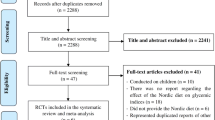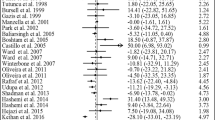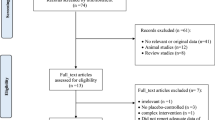Abstract
Although several studies have evaluated the effect of synbiotic intake on metabolic profiles in patients with diabetes, findings are inconsistent. This systematic review and meta-analysis of randomized controlled trials (RCTs) was conducted to summarize the evidence on the effect of synbiotic intake on metabolic profiles in patients with diabetes. The PubMed, EMBASE, Web of Science, and Cochrane Library databases were systematically searched. All RCTs published up to 12 November 2016 were included. Two review authors independently assessed study eligibility, extracted data, and evaluated risk of bias of included studies. Heterogeneity was measured with a Q test and with I 2 statistics. Data were pooled by using the fix or random-effect model based on the heterogeneity test results and expressed as standardized mean difference (SMD) with 95% confidence interval (CI). A total of seven randomized controlled trials were included. Synbiotic consumption significantly changed glucose metabolism, including fasting plasma glucose (FPG) (SMD = −0.29; 95% CI, −0.47, −0.10), insulin concentrations (SMD = −0.84; 95% CI, −1.61, −0.06), homeostasis model assessment of insulin resistance (HOMA-IR) (SMD = −0.80; 95% CI, −1.58, −0.03), homeostatic model assessment-B cell function (HOMA-B) (SMD = −0.36; 95% CI, −0.71, −0.01), quantitative insulin sensitivity check index (QUICKI) (SMD = 0.46; 95% CI, 0.09, 0.82), and significantly improved lipid profiles, such as triglycerides (SMD = −0.36; 95% CI, −0.55, −0.17), very low density lipoprotein-cholesterol (SMD = −0.31; 95% CI, −0.55, −0.08), and total cholesterol (SMD = −0.32; 95% CI, −0.67, −0.03), but had no effect on low density lipoprotein-cholesterol (SMD = −0.07; 95% CI, −0.58, 0.43) and high density lipoprotein-cholesterol concentrations (SMD = −0.25; 95% CI, −0.81, 0.31). Synbiotic may result in an improvement in FPG, insulin, HOMA-IR, HOMA-B, QUICKI, triglycerides, and total cholesterol.








Similar content being viewed by others
References
McGillicuddy FC, Roche HM (2012) Nutritional status, genetic susceptibility, and insulin resistance—important precedents to atherosclerosis. Mol Nutr Food Res 56:1173–1184. doi:10.1002/mnfr.201100785
Schubert CM, Rogers NL, Remsberg KE, Sun SS, Chumlea WC, Demerath EW, Czerwinski SA, Towne B, Siervogel RM (2006) Lipids, lipoproteins, lifestyle, adiposity and fat-free mass during middle age: the Fels Longitudinal Study. Int J Obes 30:251–260
Moosheer SM, Waldschutz W, Itariu BK, Brath H, Stulnig TM (2014) A protein-enriched low glycemic index diet with omega-3 polyunsaturated fatty acid supplementation exerts beneficial effects on metabolic control in type 2 diabetes. Prim Care Diabetes 8:308–314. doi:10.1016/j.pcd.2014.02.004
Asemi Z, Hashemi T, Karamali M, Samimi M, Esmaillzadeh A (2013) Effects of vitamin D supplementation on glucose metabolism, lipid concentrations, inflammation, and oxidative stress in gestational diabetes: a double-blind randomized controlled clinical trial. Am J Clin Nutr 98:1425–1432. doi:10.3945/ajcn.113.072785
Gao D, Ning N, Wang C, Wang Y, Li Q, Meng Z, Liu Y, Li Q (2013) Dairy products consumption and risk of type 2 diabetes: systematic review and dose-response meta-analysis. PLoS One 8:e73965. doi:10.1371/journal.pone.0073965
de Vrese M, Schrezenmeir J (2008) Probiotics, prebiotics, and synbiotics. Adv Biochem Eng Biotechnol 111:1–66. doi:10.1007/10_2008_097
Sáez-Lara MJ, Robles-Sanchez C, Ruiz-Ojeda FJ, Plaza-Diaz J, Gil A (2016) Effects of Probiotics and Synbiotics on Obesity, Insulin Resistance Syndrome, Type 2 Diabetes and Non-Alcoholic Fatty Liver Disease: A Review of Human Clinical Trials. Int J Mol Sci :17(6). doi:10.3390/ijms17060928.
Shakeri H, Hadaegh H, Abedi F, Tajabadi-Ebrahimi M, Mazroii N, Ghandi Y, Asemi Z (2014) Consumption of synbiotic bread decreases triacylglycerol and VLDL levels while increasing HDL levels in serum from patients with type-2 diabetes. Lipids 49:695–701. doi:10.1007/s11745-014-3901-z
Beserra BT, Fernandes R, do Rosario VA, Mocellin MC, Kuntz MG, Trindade EB (2015) A systematic review and meta-analysis of the prebiotics and synbiotics effects on glycaemia, insulin concentrations and lipid parameters in adult patients with overweight or obesity. Clin Nutr 34:845–858. doi:10.1016/j.clnu.2014.10.004
Ruan Y, Sun J, He J, Chen F, Chen R, Chen H (2015) Effect of probiotics on glycemic control: a systematic review and meta-analysis of randomized, controlled trials. PLoS One 10:e0132121. doi:10.1371/journal.pone.0132121
Vitali B, Ndagijimana M, Maccaferri S, Biagi E, Guerzoni ME, Brigidi P (2012) An in vitro evaluation of the effect of probiotics and prebiotics on the metabolic profile of human microbiota. Anaerobe 18:386–391. doi:10.1016/j.anaerobe.2012.04.014
Voltolini C, Battersby S, Etherington SL, Petraglia F, Norman JE, Jabbour HN (2012) A novel antiinflammatory role for the short-chain fatty acids in human labor. Endocrinology 153:395–403. doi:10.1210/en.2011-1457
Roberfroid M, Gibson GR, Hoyles L, McCartney AL, Rastall R, Rowland I, Wolvers D, Watzl B, Szajewska H, Stahl B, Guarner F, Respondek F, Whelan K, Coxam V, Davicco MJ, Léotoing L, Wittrant Y, Delzenne NM, Cani PD, Neyrinck AM, Meheust A (2010) Prebiotic effects: metabolic and health benefits. Br J Nutr 104(Suppl 2):S1–S6. doi:10.1017/S0007114510003363
Ahmadi S, Jamilian M, Tajabadi-Ebrahimi M, Jafari P, Asemi Z (2016) The effects of synbiotic supplementation on markers of insulin metabolism and lipid profiles in gestational diabetes: a randomised, double-blind, placebo-controlled trial. Br J Nutr 116:1394–1401. doi:10.1017/S0007114516003457
Asemi Z, Khorrami-Rad A, Alizadeh SA, Shakeri H, Esmaillzadeh A (2014) Effects of synbiotic food consumption on metabolic status of diabetic patients: a double-blind randomized cross-over controlled clinical trial. Clin Nutr 33:198–203. doi:10.1016/j.clnu.2013.05.015
Asemi Z, Alizadeh SA, Ahmad K, Goli M, Esmaillzadeh A (2016) Effects of beta-carotene fortified synbiotic food on metabolic control of patients with type 2 diabetes mellitus: a double-blind randomized cross-over controlled clinical trial. Clin Nutr 35:819–825. doi:10.1016/j.clnu.2015.07.009
Moroti C, Souza Magri LF, de Rezende CM, Cavallini DC, Sivieri K (2012) Effect of the consumption of a new symbiotic shake on glycemia and cholesterol levels in elderly people with type 2 diabetes mellitus. Lipids Health Dis 11:29. doi:10.1186/1476-511X-11-29
Tajabadi-Ebrahimi M, Sharifi N, Farrokhian A, Raygan F, Karamali F, Razzaghi R, Taheri S, Asemi Z (2017) A randomized controlled clinical trial investigating the effect of synbiotic administration on markers of insulin metabolism and lipid profiles in overweight type 2 diabetic patients with coronary heart disease. Exp Clin Endocrinol Diabetes 125:21–27. doi:10.1055/s-0042-105441
Tajadadi-Ebrahimi M, Bahmani F, Shakeri H, Hadaegh H, Hijijafari M, Abedi F, Asemi Z (2014) Effects of daily consumption of synbiotic bread on insulin metabolism and serum high-sensitivity C-reactive protein among diabetic patients: a double-blind, randomized, controlled clinical trial. Ann Nutr Metab 65:34–41. doi:10.1159/000365153
Gomes AC, Bueno AA, de Souza RG, Mota JF (2014) Gut microbiota, probiotics and diabetes. Nutr J 13:60. doi:10.1186/1475-2891-13-60
Larsen N, Vogensen FK, van den Berg FW, Nielsen DS, Andreasen AS, Pedersen BK, Al-Soud WA, Sørensen SJ, Hansen LH, Jakobsen M (2010) Gut microbiota in human adults with type 2 diabetes differs from non-diabetic adults. PLoS One 5:e9085. doi:10.1371/journal.pone.0009085
Kasinska MA, Drzewoski J (2015) Effectiveness of probiotics in type 2 diabetes: a meta-analysis. Pol Arch Med Wewn 125:803–813. doi:10.20452/pamw.3156
Samah S, Ramasamy K, Lim SM, Neoh CF (2016) Probiotics for the management of type 2 diabetes mellitus: a systematic review and meta-analysis. Diabetes Res Clin Pract 118:172–182. doi:10.1016/j.diabres.2016.06.014
Chapman CM, Gibson GR, Rowland I (2011) Health benefits of probiotics: are mixtures more effective than single strains? Eur J Nutr 50:1–17. doi:10.1007/s00394-010-0166-z
Prudente S, Trischitta V (2015) The TRIB3 Q84R polymorphism, insulin resistance and related metabolic alterations. Biochem Soc Trans 43:1108–1111. doi:10.1042/BST20150115
Ejtahed HS, Mohtadi-Nia J, Homayouni-Rad A, Niafar M, Asghari-Jafarabadi M, Mofid V (2012) Probiotic yogurt improves antioxidant status in type 2 diabetic patients. Nutrition 28:539–543. doi:10.1016/j.nut.2011.08.013
Amaretti A, di Nunzio M, Pompei A, Raimondi S, Rossi M, Bordoni A (2013) Antioxidant properties of potentially probiotic bacteria: in vitro and in vivo activities. Appl Microbiol Biotechnol 97:809–817. doi:10.1007/s00253-012-4241-7
Uskova MA, Kravchenko LV (2009) Antioxidant properties of lactic acid bacteria—probiotic and yogurt strains. Vopr Pitan 78:18–23
Yadav H, Jain S, Sinha PR (2007) Antidiabetic effect of probiotic dahi containing Lactobacillus acidophilus and Lactobacillus casei in high fructose fed rats. Nutrition 23:62–68
de Moreno de Leblanc A, Perdigon G (2010) The application of probiotic fermented milks in cancer and intestinal inflammation. Proc Nutr Soc 69:421–428. doi:10.1017/S002966511000159X
Shi H, Kokoeva MV, Inouye K, Tzameli I, Yin H, Flier JS (2006) TLR4 links innate immunity and fatty acid-induced insulin resistance. J Clin Invest 116:3015–3025
Deepak V, Ram Kumar Pandian S, Sivasubramaniam SD, Nellaiah H, Sundar K (2016) Optimization of anticancer exopolysaccharide production from probiotic Lactobacillus acidophilus by response surface methodology. Prep Biochem Biotechnol 46:288–297. doi:10.1080/10826068.2015.1031386
Dewulf EM, Cani PD, Neyrinck AM, Possemiers S, Van Holle A, Muccioli GG, Deldicque L, Bindels LB, Pachikian BD, Sohet FM, Mignolet E, Francaux M, Larondelle Y, Delzenne NM (2011) Inulin-type fructans with prebiotic properties counteract GPR43 overexpression and PPARgamma-related adipogenesis in the white adipose tissue of high-fat diet-fed mice. J Nutr Biochem 22:712–722. doi:10.1016/j.jnutbio.2010.05.009
Wang Y, Xie J, Li Y, Dong S, Liu H, Chen J, Wang Y, Zhao S, Zhang Y, Zhang H (2016) Probiotic Lactobacillus casei Zhang reduces pro-inflammatory cytokine production and hepatic inflammation in a rat model of acute liver failure. Eur J Nutr 55:821–831. doi:10.1007/s00394-015-0904-3
Weitkunat K, Schumann S, Petzke KJ, Blaut M, Loh G, Klaus S (2015) Effects of dietary inulin on bacterial growth, short-chain fatty acid production and hepatic lipid metabolism in gnotobiotic mice. J Nutr Biochem 26:929–937. doi:10.1016/j.jnutbio.2015.03.010
Cho YA, Kim J (2015) Effect of probiotics on blood lipid concentrations: a meta-analysis of randomized controlled trials. Medicine (Baltimore) 94:e1714. doi:10.1097/MD.0000000000001714
Shimizu M, Hashiguchi M, Shiga T, Tamura HO, Mochizuki M (2015) Meta-analysis: effects of probiotic supplementation on lipid profiles in normal to mildly hypercholesterolemic individuals. PLoS One 10:e0139795. doi:10.1371/journal.pone.0139795
Agerholm-Larsen L, Bell ML, Grunwald GK, Astrup A (2000) The effect of a probiotic milk product on plasma cholesterol: a meta-analysis of short-term intervention studies. Eur J Clin Nutr 54:856–860
Matsuoka H, Miura A, Hori K (2009) Symbiotic effects of a lipase-secreting bacterium, Burkholderia arboris SL1B1, and a glycerol-assimilating yeast, Candida cylindracea SL1B2, on triacylglycerol degradation. J Biosci Bioeng 107:401–408. doi:10.1016/j.jbiosc.2008
Yadav H, Lee JH, Lloyd J, Walter P, Rane SG (2013) Beneficial metabolic effects of a probiotic via butyrate-induced GLP-1 hormone secretion. J Biol Chem 288:25088–25097. doi:10.1074/jbc.M113.452516
Klaver FA, van der Meer R (1993) The assumed assimilation of cholesterol by Lactobacilli and Bifidobacterium bifidum is due to their bile salt-deconjugating activity. Appl Environ Microbiol 59:1120–1124
Lye H-S, Rahmat-Ali GR, Liong M-T (2010) Mechanisms of cholesterol removal by lactobacilli under conditions that mimic the human gastrointestinal tract. Int Dairy J 20:169–175. doi:10.1016/j.idairyj.2009.10.003
Gill SR, Pop M, Deboy RT, Eckburg PB, Turnbaugh PJ, Samuel BS, Gordon JI, Relman DA, Fraser-Liggett CM, Nelson KE (2006) Metagenomic analysis of the human distal gut microbiome. Science 312:1355–1359
Wu GD, Chen J, Hoffmann C, Bittinger K, Chen YY, Keilbaugh SA, Bewtra M, Knights D, Walters WA, Knight R, Sinha R, Gilroy E, Gupta K, Baldassano R, Nessel L, Li H, Bushman FD, Lewis JD (2011) Linking long-term dietary patterns with gut microbial enterotypes. Science 334:105–108. doi:10.1126/science.1208344
Arboleya S, Ang L, Margolles A, Yiyuan L, Dongya Z, Liang X, Solís G, Fernández N, de Los Reyes-Gavilán CG, Gueimonde M (2012) Deep 16S rRNA metagenomics and quantitative PCR analyses of the premature infant fecal microbiota. Anaerobe 18:378–380. doi:10.1016/j.anaerobe.2012.04.013
Perez-Cobas AE, Artacho A, Knecht H, Ferrús ML, Friedrichs A, Ott SJ, Moya A, Latorre A, Gosalbes MJ (2013) Differential effects of antibiotic therapy on the structure and function of human gut microbiota. PLoS One 8:e80201. doi:10.1371/journal.pone.0080201
Gibson GR, Roberfroid MB (1995) Dietary modulation of the human colonic microbiota: introducing the concept of prebiotics. J Nutr 125:1401–1412
Gibson GR, Probert HM, Loo JV, Rastall RA, Roberfroid MB (2004) Dietary modulation of the human colonic microbiota: updating the concept of prebiotics. Nutr Res Rev 17:259–275
Ivey KL, Hodgson JM, Kerr DA, Lewis JR, Thompson PL, Prince RL (2014) The effects of probiotic bacteria on glycaemic control in overweight men and women: a randomised controlled trial. Eur J Clin Nutr 68:447–452. doi:10.1038/ejcn.2013.294
Author information
Authors and Affiliations
Corresponding author
Ethics declarations
Conflict of Interest
The authors declare that they have no conflict of interest.
For Studies with Human Subjects
All procedures in selected papers followed were in accordance with the ethical standards of the responsible committee on human experimentation (institutional and national) and with the Helsinki Declaration of 1975, as revised in 2008. Informed consent was obtained from all patients for being included in the study.
Funding
The current study was founded by a grant from the Vice Chancellor for Research, KUMS, in Iran.
Rights and permissions
About this article
Cite this article
Tabrizi, R., Moosazadeh, M., Lankarani, K.B. et al. The Effects of Synbiotic Supplementation on Glucose Metabolism and Lipid Profiles in Patients with Diabetes: a Systematic Review and Meta-Analysis of Randomized Controlled Trials. Probiotics & Antimicro. Prot. 10, 329–342 (2018). https://doi.org/10.1007/s12602-017-9299-1
Published:
Issue Date:
DOI: https://doi.org/10.1007/s12602-017-9299-1




